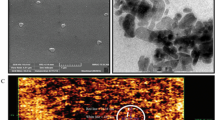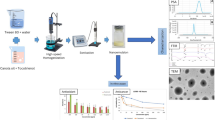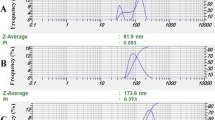Abstract
Viola odorata essential oil has been used as an anticancer compound for its salubrious ingredients. Their bioactive components can be protected and made more accessible through triggering nanotechnology methods. The current study aimed to produce V. odorata essential oil nanoemulsions as a drug delivery system for the first time, as well as assessing its apoptotic effect on A2780 cells and anti-angiogenic potentials. In this regard, the nanoemulsions were synthesized through employing the ultrasound-based nanoemulsification approach and characterized by using TEM, DLS, and zeta potential. Then, supplementary tests were implemented to verify their cytotoxic, apoptotic, and anti-angiogenic properties. In general, the results represented that 50.98-nm VEO-NE significantly decreased the viability of the A2780 ovarian cancer cells compared to the HFF normal cells and induced apoptotic response. Additionally, the results were further confirmed by the upregulation of caspase-3, and downregulation of vascular endothelial growth factor (VEGF) and vascular endothelial growth factor receptor 2 (VEGFR-2) genes. Thus, the prepared nanoemulsions can be utilized as a safe cell-selective anticancer drug delivery system and may be a promising compound for enriched foods in the food industry.
Graphical Abstract






Similar content being viewed by others
References
Bray, F., et al.: Global cancer statistics 2018: GLOBOCAN estimates of incidence and mortality worldwide for 36 cancers in 185 countries. CA: Cancer J. Clin. 68(6), 394–424 (2018)
Unterleuthner, D., et al.: Cancer-associated fibroblast-derived WNT2 increases tumor angiogenesis in colon cancer. Angiogenesis 23, 159–177 (2020)
Bolatai, A., He, Y., Wu, N..J..J..o.T..M.: Vascular endothelial growth factor and its receptors regulation in gestational diabetes mellitus and eclampsia. J. Trans. Med. 20(1), 400 (2022)
Chaft, J.E., et al.: Evolution of systemic therapy for stages I-III non-metastatic non-small-cell lung cancer. Nature Rev. 18(9), 547–557 (2021)
Gezici, S., Şekeroğlu, N.: Current perspectives in the application of medicinal plants against cancer: novel therapeutic agents. Anticancer Agents Med. Chem. 19(1), 101–111 (2019)
Massounga Bora, A.F., et al.: Application of microencapsulation for the safe delivery of green tea polyphenols in food systems: review and recent advances. Food Res. Int. 105, 241–249 (2018)
Kumari, P., Ghosh, B., Biswas, S.: Nanocarriers for cancer-targeted drug delivery. J. Drug Target. 24(3), 179–191 (2016)
Kim, J.-E., Park, Y.-J.: Paclitaxel-loaded hyaluronan solid nanoemulsions for enhanced treatment efficacy in ovarian cancer. Int. J. Nanomed. 12, 645 (2017)
Groo, A.C., et al.: Pyridoclax-loaded nanoemulsion for enhanced anticancer effect on ovarian cancer. Int. J. Pharm. (2020). https://doi.org/10.1016/j.ijpharm.2020.119655
Kubatka, P., et al.: Anticancer activities of Thymus vulgaris L. in experimental breast carcinoma in vivo and in vitro. Int. J. Mol. Sci. 20(7), 1749 (2019)
Maragheh, A.D., et al.: Producing the sour cherry pit oil nanoemulsion and evaluation of its anti-cancer effects on both breast cancer murine model and MCF-7 cell line. J. Microencapsul. 36(4), 399–409 (2019)
Anuchapreeda, S., et al.: Preparation of lipid nanoemulsions incorporating curcumin for cancer therapy. J. Nanatechnol. (2012). https://doi.org/10.1155/2012/270383
Nirmala, M.J., et al.: Anticancer and antibacterial effects of a clove bud essential oil-based nanoscale emulsion system. Int. J. Nanomed. 14, 6439 (2019)
Nikmanesh, A., Baghaei, H., Mohammadi Nafchi, A.J.F.: Development and characterization of antioxidant and antibacterial films based on potato starch incorporating Viola odorata extract to improve the oxidative and microbiological quality of chicken fillets during refrigerated storage. Foods 12(15), 2955 (2023)
Zawiślak, A., et al.: Impact of drying conditions on antioxidant activity of red clover(Trifolium pratense), sweet violet(Viola odorata)and elderberry flowers(Sambucus nigra). Materials 15(9), 3317 (2022)
Yousefnia, S., et al.: Suppressive role of Viola odorata extract on malignant characters of mammosphere-derived breast cancer stem cells. Clinical Trans. Oncology. 22, 1619–1634 (2020)
Parsley, N.C., et al.: PepSAVI-MS reveals anticancer and antifungal cycloviolacins in Viola odorata. Phytochemistry. 152, 61–70 (2018)
Aswathanarayan, J.B., Vittal, R.R.: Nanoemulsions and their potential applications in food industry. Front. Sustainable Food Syst. 3, 95 (2019)
Liu, Q., et al.: Food-grade nanoemulsions: preparation, stability and application in encapsulation of bioactive compounds. Molecules 24(23), 4242 (2019)
Saffarionpour, S.J.F.E.R.: Preparation of food flavor nanoemulsions by high-and low-energy emulsification approaches. Food Eng. Rev. 11(4), 259–289 (2019)
Guida, C., Aguiar, A.C.: Green techniques for starch modification to stabilize Pickering emulsions: a current review and future perspectives. Current Opinion Food Sci. 38, 52–61 (2021)
Amiri-Rigi, A., Abbasi, S., Emmambux, M.N.J.F.R.I.: Background, limitations, and future perspectives in food grade microemulsions and nanoemulsions. Food Rev. Int. (2022). https://doi.org/10.1080/87559129.2022.2059808
Dhull, S.B., Anju, M., Punia, S., Kaushik, R., Chawla, P.: Application of gum Arabic in nanoemulsion for safe conveyance of bioactive components. In: Prasad, R., Kumar, V., Kumar, M., Choudhary, D. (eds.) Nanobiotechnology in Bioformulations. Springer, Cham (2019). https://doi.org/10.1007/978-3-030-17061-5_3
Heidari, F., et al.: Stability and release mechanisms of double emulsions loaded with bioactive compounds; a critical review. 299: p. 102567. (2022)
Sneha, K., A.J.I.F, S., Kumar, Technologies, E.: Nanoemulsions: Techniques for the Preparation and the Recent Advances in Their food Applications. 76, 102914 (2022)
Borthakur, P., et al.: 5 - Nanoemulsion: preparation and its application in food industry, in Emulsions, A.M. Grumezescu, (eds). Academic Press. p. 153–191. (2016)
Jaiswal, M., Dudhe, R., Sharma, P.K.: Nanoemulsion: An. Advanced mode of drug Delivery System 3 Biotech. 5(2), 123–127 (2015)
Jacob, S., et al.: Lipid nanoparticles as a promising drug delivery carrier for topical ocular therapy—an overview on recent advances. Pharmaceutics 14(3), 533 (2022)
Javanshir, A., et al.: The antioxidant and anticancer potential of Ricinus communis L. essential oil nanoemulsions. J. Food Measure. Charact. 14, 1356–1365 (2020)
Paudel, S.K., Bhargava, K., Kotturi, H.J.L.: Antimicrobial activity of cinnamon oil nanoemulsion against Listeria monocytogenes and Salmonella spp. on melons. LTW 111, 682–687 (2019)
Lin, W., Ye, H.: Anticancer activity of ursolic acid on human ovarian cancer cells via ROS and MMP mediated apoptosis, cell cycle arrest and downregulation of PI3K/AKT pathway. J. Buon. 25(2), 750–756 (2020)
Sanaeimehr, Z., Javadi, I., Namvar, F.: Antiangiogenic and antiapoptotic effects of green-synthesized zinc oxide nanoparticles using Sargassum muticum algae extraction. Cancer Nanotechnol. 9(1), 3 (2018)
Stetefeld, J., McKenna, S.A., Patel, T.R.: Dynamic light scattering: a practical guide and applications in biomedical sciences. Biophys. Rev. 8(4), 409–427 (2016)
Salopek, B., Krasic, D., Filipovic, S.: Measurement and application of zeta-potential. Rudarsko-geolosko-naftni Zbornik. 4(1), 147 (1992)
Li, P.-H., Lu, W.-C.: Effects of storage conditions on the physical stability of d-limonene nanoemulsion. Food Hydrocoll. 53, 218–224 (2016)
Almatroodi, S.A., et al.: Potential therapeutic targets of epigallocatechin gallate (EGCG), the most abundant catechin in green tea, and its role in the therapy of various types of cancer. Molecules 25(14), 3146 (2020)
Vukics, V., et al.: Major flavonoid components of heartsease (Viola tricolor L.) and their antioxidant activities. Anal. Bioanal. Chem. 390(7), 1917–1925 (2008)
Gerlach, S.L., et al.: Anticancer and chemosensitizing abilities of cycloviolacin 02 from Viola odorata and Psyle cyclotides from Psychotria leptothyrsa. Biopolymers. 94(5), 617–625 (2010)
Alipanah, H., Bigdeli, M.R., Esmaeili, M.A.: Inhibitory effect of viola odorata extract on tumor growth and metastasis in 4T1 breast cancer model. Iran. J. Pharm. Research: IJPR. 17(1), 276 (2018)
Hashemi, Mansoureh, et al. Apoptosis induced by Viola odorata extract in human glioblastoma multiforme. Archives Neurosci. 6(1) (2019).
Dzreyan, V., et al.: The expression of E2F1, p53, and caspase 3 in the rat dorsal root ganglia after sciatic nerve transection. J. Molecular Neurosci. 71, 826–835 (2021)
Kasture, V., et al.: Placental apoptotic markers are associated placental morphometry. Placenta 115, 1–11 (2021)
Hou, J., et al.: α-Pinene induces apoptotic cell death via caspase activation in human ovarian cancer cells. Med. Sci. Monitor: Int. Med. J. Exp. Clin. Res. 25, 6631 (2019)
Zeinoddini, S., Nabiuni, M., Jalali, H.: The synergistic cytotoxic effects of doxorubicin and Viola odorata extract on human breast cancer cell line T47-D. J. Cancer Res. Ther. 15(5), 1073–1079 (2019)
Wittig, C., et al.: Geraniol suppresses angiogenesis by downregulating vascular endothelial growth factor (VEGF)/VEGFR-2 signaling. PLoS One. 10(7), e0131946 (2015)
Vinothkumar, V., et al.: Geraniol modulates cell proliferation, apoptosis, inflammation, and angiogenesis during 7,12-dimethylbenz[a]anthracene-induced hamster buccal pouch carcinogenesis. Mol. Cell. Biochem. 369(1–2), 17–25 (2012)
Funding
The authors have not disclosed any funding.
Author information
Authors and Affiliations
Corresponding author
Ethics declarations
Conflict of interest
The authors have no conflicts of interest to declare.
Ethical Approval
Not applicable.
Additional information
Publisher’s Note
Springer nature remains neutral with regard to jurisdictional claims in published maps and institutional affiliations.
Rights and permissions
Springer Nature or its licensor (e.g. a society or other partner) holds exclusive rights to this article under a publishing agreement with the author(s) or other rightsholder(s); author self-archiving of the accepted manuscript version of this article is solely governed by the terms of such publishing agreement and applicable law.
About this article
Cite this article
Sahib Abed, H., Zarearki, P., Khojasteh, V. et al. Inhibition the Growth of Human Ovarian Cancer Cells (A2780) via Cell Proliferation and Angiogenesis by Viola odorata Essential Oil Nanoemulsion. Waste Biomass Valor 15, 2417–2426 (2024). https://doi.org/10.1007/s12649-023-02314-1
Received:
Accepted:
Published:
Issue Date:
DOI: https://doi.org/10.1007/s12649-023-02314-1




